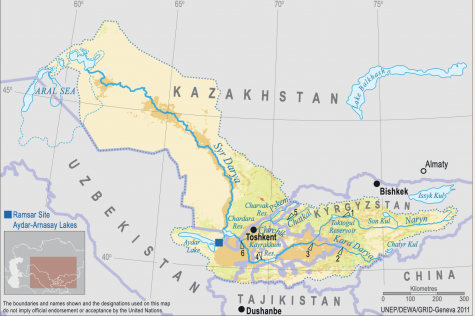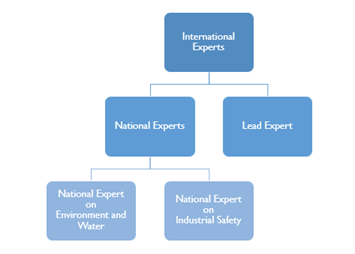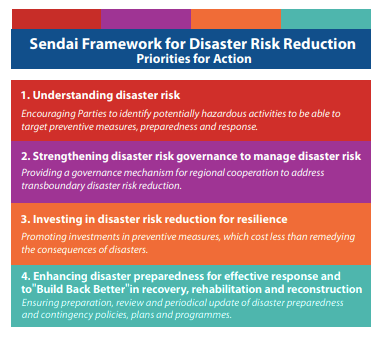1. Background

During the 2021 – 2023, the United Nations Economic Commission for Europe (UNECE), in cooperation with the International Water Assessment Centre (IWAC), was implementing a project on the compilation and analysis of information on existing national and joint measures to prevent and respond to pollution in the Syr Darya river basin in emergency situations , thanks to the financial support from the European Union. This work was carried out by the UNECE Convention on the Protection and Use of Transboundary Watercourses and International Lakes (Water Convention), with significant contributions of the UNECE Convention on the Transboundary Effects of Industrial Accidents (Industrial Accidents Convention), which provide a legal framework to support countries in their efforts to prevent accidental water pollution. The Project resulted in the development of the following:
- An in-depth report addressing the state of water resources, water quality issues and issues related to policies and institutions for water management, industrial safety and prevention of accidental water pollution. The report contains concrete recommendations for riparian countries on next steps to improve transboundary contingency planning and reducing water pollution, including an executive summary with findings (available in English and Russian).
- An inventory and map of 61 tailings management facilities (TMFs) - 9 in Kazakhstan, 30 in Kyrgyzstan, 12 in Uzbekistan, and 10 in Tajikistan - and 133 other hazardous industrial facilities, including 33 TMFs with potential transboundary effects in the Syr Darya River Basin.
- Infographics visualizing key findings from the report (in English and Russian).
Industrial accidents at hazardous chemical facilities, including at tailings management facilities, as well as other industrial activities can cause water pollution and can have a significant transboundary impact when this occurs in a transboundary river basin. The integration of industrial risks, notably tailings risks, in river basin management plans, as well as the enhancement of cooperation between industrial safety and water experts are key to effectively prevent water pollution and its negative impact in the Syr Darya river basin. Besides, understanding of disaster risks, including Natech risks, i.e. technological accidents triggered by natural hazards (such as floods, landslides or earthquakes), is essential, as the countries of Central Asia are prone to Natech accidents due to climate change, which causes extreme weather events and change in weather patterns. Therefore, the adoption of (national and joint) measures by riparian countries to prevent and respond to pollution of the Syr Darya river basin in emergency situations is highly relevant. Given that there is no Joint Contingency Plan for the Syr Darya river basin, development of such plan and harmonized procedures is vital. However, it is important to first collect the information from the riparian countries.
In view of that, UNECE, in cooperation with the IWAC, assisted the four riparian countries of the Syr Darya river basin – Kazakhstan, Kyrgyzstan, Tajikistan and Uzbekistan – in reviewing existing (national and joint) measures and the development of recommendations to prevent and respond to water pollution in the Syr Daria river basin, as part of Phase I of the Project. The potential sources of pollution in the Syr Darya river basin were assessed by a group of experts and in cooperation with the competent authorities from all the riparian countries of the Syr Darya river basin.
The Project was implemented within the framework of the regional project for Central Asia on European Union Water Initiative National Water Policy Dialogues (NPDs) and the European Union-Central Asia Water, Environment and Climate Change Cooperation (WECOOP) Programme. Furthermore, the Project was complementary to other past and on-going efforts of the UNECE in the region, such as:
- UNECE Projects on strengthening mine tailings safety Kazakhstan (2017-2019), Tajikistan (2019-2021), Uzbekistan (since 2021) and Central Asia (since 2020), financed by the Swiss Federal Office for the Environment;
- UNECE Online Toolkit and Training for Strengthening Mine Tailings Safety;
- UNECE Project on National Policy Dialogues for Industrial Safety in Central Asia (Phase I: Launch) (since 2020), financed by the Russian Federation.
2. Project Objectives
The overall objective of the Project was to reduce and prevent pollution of the water resources of the transboundary Syr Darya river basin. In particular, the Project aimed to:
- Take stock of the impact of potential industrial pollution sources located in the flow formation zone of the Syr Darya river basin;
- Review and analyze the existing national measures of riparian countries to prevent and respond to pollution in the Syr Darya river basin in emergency situations, including industrial accidents;
- Initiate a discussion between the riparian countries to strengthen transboundary contingency planning, resulting into concrete recommendations for improving the planning process.
3. Project Beneficiaries and Project Design

The main beneficiaries of the Project were the four riparian countries of the Syr Darya river basin, i.e. Kazakhstan, Kyrgyzstan, Tajikistan and Uzbekistan, namely its competent authorities under the Water and Industrial Accidents Conventions.
The Project was carried out in close collaboration with a group of national experts (two experts per riparian country – one on environment and water, and one on industrial safety) as well as international experts. The national experts are responsible for the compilation the relevant information, drafting a report and regularly convene to discuss the progress of their work with the lead expert and international experts. These meetings were led by IWAC and supported by UNECE

4. Project Activities
In order to reach the Project’s objectives, the following activities were being carried out:
- Identification and mapping of potential sources of pollution and main pollutants in the Syr Darya River Basin, including with regard to technological accidents triggered by natural hazards (Natech risks);
- Development of an analytical report with describing the potential sources of pollution and main pollutants in the Syr Darya River Basin, based on the inputs of all national experts;
- Development of recommendations for reducing pollution of the Syr Darya River Basin, based on the inputs of all national experts;
- Conduct of technical meetings among all national experts (21 December 2021, 19 January 2022, 8 February 2022, 25 February 2022, 18 March 2022, 29 April 2022, 27 July 2022 and 19 August 2022 and 20 December 2022) or among the industrial safety experts (24 January 2022);
- Exchange of information and sharing of project results at the Subregional workshop on mine tailings safety and the prevention of accidental water pollution in Central Asia (Dushanbe, 25-26 May 2023), involving both water and industrial safety experts.
Furthermore, the Project supported the beneficiary countries in implementing the Sendai Framework for Disaster Risk Reduction for 2015-2030, notably in achieving its objectives and its four priorities, namely:
- Enhance the understanding of disaster risk.
- Strengthen disaster risk governance in order to decrease disaster risk.
- Invest in disaster risk reduction for resilience.
- Enhance disaster preparedness.

The Project also supported riparian countries in achieving the 2030 Agenda for Sustainable development with its SDGs, notably the following:
- SDG 6, notably, Target 6.3: By 2030, improve water quality by reducing pollution, eliminating dumping and minimizing release of hazardous chemicals and materials, halving the proportion of untreated wastewater and substantially increasing recycling and safe reuse globally.
- SDG 9: To build resilient infrastructure, promote inclusive and sustainable industrialization and foster innovation.
- SDG 11, notably, Target 11.b: By 2020, substantially increase the number of cities and human settlements adopting and implementing integrated policies and plans towards inclusion, resource efficiency, mitigation and adaptation to climate change, resilience to disasters, and develop and implement, in line with the Sendai Framework for Disaster Risk Reduction 2015-2030, holistic disaster risk management at all levels.
5. Results
The Project contributed to:
- Increased understanding of disaster risks in the Syr Darya River Basin, including with regard to Natech risks;
- Identification of potential sources of accidental pollution in the Syr Darya River Basin;
- Improved management of disaster risks in the Syr Darya River Basin;
- Enhanced cooperation between riparian countries in reducing the risks of accidental pollution of the Syr Darya River Basin;
- Establishment of a basis for the coordinated mechanism for preventing and responding to pollution in emergency situations in the Syr Darya River Basin;
- Improved exchange of information and coordination between the national authorities of the riparian countries to improve safety and prevent pollution of the Syr Darya River Basin from tailing facilities.